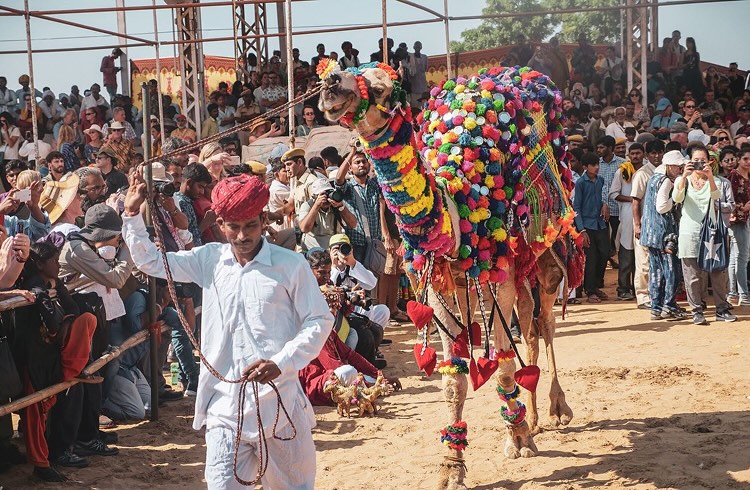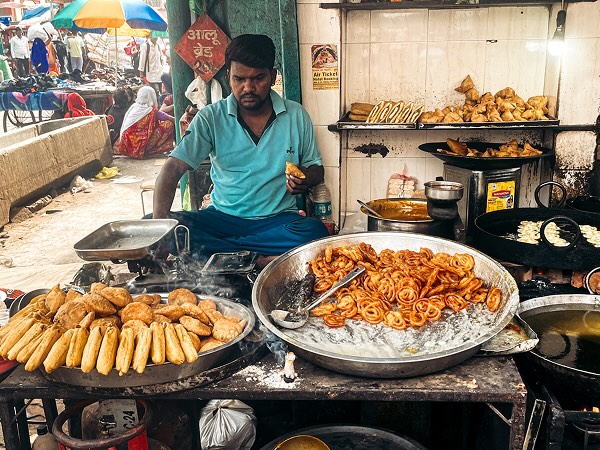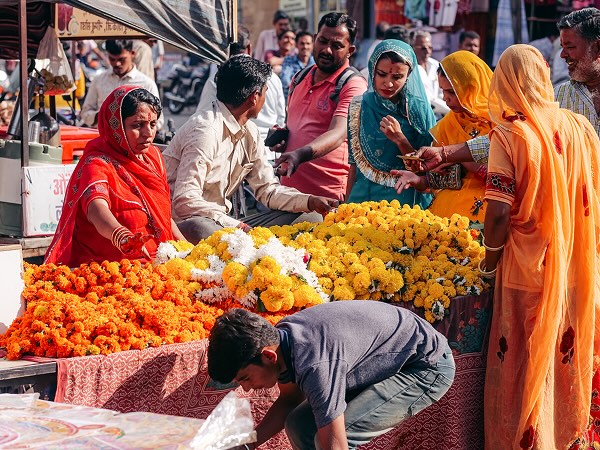India Travel Safety: How to Stay Healthy & Travel Smart
Traveling to India? This guide shares essential safety tips—from avoiding Delhi belly to navigating scams, road safety, and women’s safety. Learn what to expect and how to stay safe, healthy, and informed.
 Photo © Alicia Erickson
Photo © Alicia Erickson
India conjures up a range of images: yoga, meditation, Ayurveda, and age-old traditions; technicolored clothing and vibrant celebrations; spicy curries and bustling chaat stands. Picture snowy mountains, dense jungles, vast deserts, tuk-tuks weaving through traffic, and long train rides across the country. For many, India’s sensory overload is part of the appeal—though for others, it may feel overwhelming.
Spanning over 1.2 million square miles and home to nearly 1.5 billion people who speak more than 750 languages, India is vast and incredibly diverse. Naturally, your experience will differ depending on the region you visit.
Before I first visited India nearly a decade ago, I was equally intrigued as I was intimidated by this exciting, vibrant South Asian destination. Over the past nine years of nearly annual travel to India across many of the states from the southern jungles of Tamil Nadu to the high desert mountains of Ladakh, I have grown familiar with the ins and outs, highs and lows of exploring this incredible country. While India presents its challenges, it's one of the most rewarding places I’ve ever traveled. Below are some key tips to help you stay safe and make the most of your journey.
Food Safety and Drinking Water Tips for Travelers in India
The “Delhi belly” is real. Food- and water-borne illnesses are among the most common grievances travelers face in India. But let’s face it, sampling the local cuisine is an integral part of experiencing India, particularly its infamous street food scene where the bites are tasty, but sanitation is inconsistent. Indulge in the local food—but with caution. Dishes that use water such as chutneys or pani puri, are best to have in a restaurant, as street food vendors won’t necessarily use filtered water. A street food tour can also help, as your guide will know where to take you to sample from clean and reputable stands.

Avoid drinking tap water. Many restaurants offer filtered water, which is typically safe to drink, but when in doubt, stick with bottled water.
An upset stomach isn’t always an indication food poisoning. The rich, spicy curries can sometimes just take some getting used to. If you do find yourself with a bout of Delhi belly, rest, hydrate, and eat bland food for a few days. If it does turn out to be a bad bout of food poisoning, having travel insurance and a 24/7 Emergency Assistance line will come in handy. The team has likely helped others through your situation and can direct you to the best clinic or pharmacy.
Learn how travel insurance may help you in India, and get a travel insurance quote.
Common Tourist Scams and Crime Safety Tips in India
Violent crime is extremely uncommon for travelers to experience in India. At most, you may experience petty theft but even pickpocketing is a rarer occurrence than in many popular travel destinations. Parts of India can be incredibly crowded, though, so keep an eye on your bag and phone in busy places including markets, train stations, or festivals such as the colorful celebrations of Holi. The only time I’ve almost encountered petty theft was at the Pushkar Camel Festival, where I stopped a group of kids trying to unzip my backpack.
You may encounter some scams along your travels in India, which will become easier to detect the longer you spend in the country. Bargain with tuk-tuk and taxi drivers and vendors at markets for fruit and crafts. The first price they quote you is likely inflated, but remember to keep the bargaining friendly and make sure they get a fair price.
India also draws many spiritual seekers to places like the ghats of Varanasi or the yoga ashrams of Rishikesh. While many Hindu holy men—or sadhus, often dressed in orange robes—are authentic, fake ones do exist. Some imposters pose as sadhus to collect donations from unsuspecting tourists.
You’ll also likely see children begging on the streets. As heartbreaking as it is, giving them money only fuels exploitative crime rings that prey on these kids. A better option is to offer them something to eat instead.
Political unrest in Kashmir
Political unrest and terrorism are rare across most of India. However, Kashmir—located in northwestern India near the Pakistan border—is an exception. The April 22, 2025 attack was the first of its kind since 2019 and heightened tensions between India and Pakistan.
Following the attacks, airports in Kashmir, Punjab, and Himachal Pradesh temporarily closed. Some flights were canceled or rerouted to avoid Pakistani airspace. Across India, mock drills were conducted, including metro shutdowns and sirens, in preparation for potential future escalations.
The situation in Kashmir remains sensitive. Always check the local news and your government’s travel advisories for the latest updates before visiting.
Is India Safe for Solo Female Travelers?
Media reports on rape, acid attacks, and sexual assault can paint India as unsafe for women. While such crimes are deeply troubling, they predominantly affect Indian women. Foreign women are less likely to be targeted.
Generally, I’ve felt incredibly comfortable travelling solo in India. I find locals welcoming, helpful, and curious to engage in conversation. In some places, you will solicit stares and small talk. People—especially young men—might ask to take a selfie with you, but I’ve generally found these encounters to be polite and harmless. Simply turn them down with a smile and keep walking.
As with anywhere, use your common sense as you’re making new friends and if you’re attending yoga schools. Most likely, you’ll have a fantastic experience at your yoga school, but with the rise of alternative travel, I have heard stories of women being violated or taken advantage by their yoga teachers or at tantra workshops.
Dress modestly—and perhaps locally. Long skirts, loose pants, crop tops, a lightweight button down, and a scarf are my go-to in India. They’re comfortable, versatile, and easy to sit on the floor in (which is a common thing in many cafes, temples, and homes.) Consider buying local clothing. Indian textiles are colorful, beautiful, and a fun way to blend in more with the local scene.

Goa is an exception for clothing. Thanks to the influx of foreigners and the beach vibe, tourist-heavy parts of Goa are okay to wear short dresses and shorts in. On the topic of Goa, it is one of a few places in India where drinking, drugs, and partying are abundant. While it can be a fun stop on your India itinerary, stay aware— especially at night and at the big psytrance parties. Because of its reputation as a party place, it has also attracted all sorts of local male tourists curious about foreign women there and is one of the few places I’ve felt uncomfortable.
For more tips, learn how safe India is for women traveling alone.
Motorbike and Road Safety in India for Tourists
Motorcycle trips are a popular way to explore India. Whether you choose to rent a motorbike and cruise across the green hills of Kerala or buy a Royal Enfield and take on the winding roads of the Himalayan regions, an Indian adventure by motorcycle is exciting. It also comes with risks. I’ve met many travelers who first learned how to drive upon buying their bikes in Delhi and immediately headed up to the mountains—a few who were holed up in hostels recovering from accidents!
Traffic in big cities is hectic and requires a lot of vigilance and confidence to navigate safely. Rural areas come with their own set of obstacles: cows, goats, potholes, and narrow, winding roads. Places like Ladakh and Spiti Valley provide incredible backdrops for two-wheeled adventures, but the mountain passes are high and narrow. Wear a helmet and take your time as you navigate these regions. Goa is another place to be careful, as the distances can be sizeable between towns along narrow, winding roads and people are driving from parties, often under the influence. Police will stop travelers quite frequently here as well.
Health and hygiene for travelers in India
Pollution can be highly problematic in major cities. It is particularly bad in New Delhi and Agra during winter months, when weather patterns mixed with burning season trap pollution and create a smog enveloping the city. Limit your visits to these areas this time of the year or if you must be there, wear a mask when you’re outside.
Health care is readily available and often quite affordable around most areas of India. Whether you need a general check-up or are facing a more specific illness, you can find a mix of western style clinics and Eastern medicine places. Pharmacies are also plentiful, where you can access medications and herbal supplements alike at affordable costs.
And if you’re curious about more traditional medicine explore practices from Ayurvedic oil massages to Tibetan clinics to panchakarma (a multi-day detoxification), your options are numerous.
Simple and flexible travel insurance
You can buy at home or while traveling, and claim online from anywhere in the world. With 150+ adventure activities covered and 24/7 emergency assistance.
Get a quote
No Comments